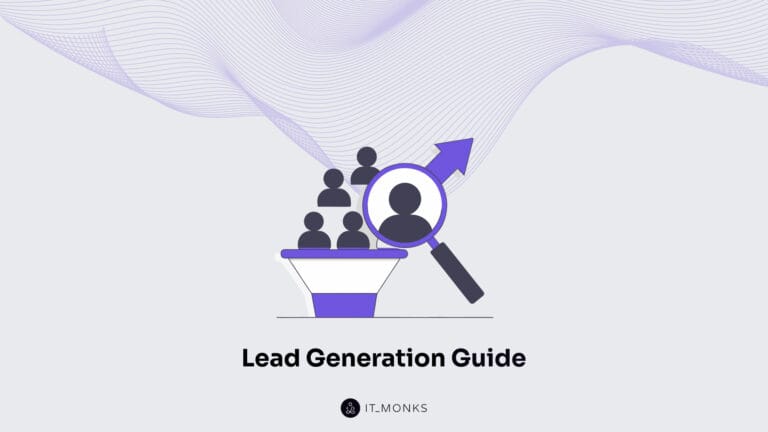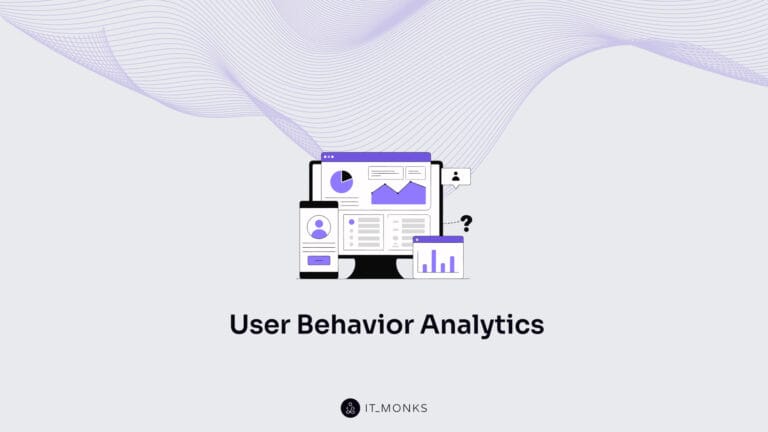Enterprise Data Modeling in Scalable Website Architecture
Table of Contents
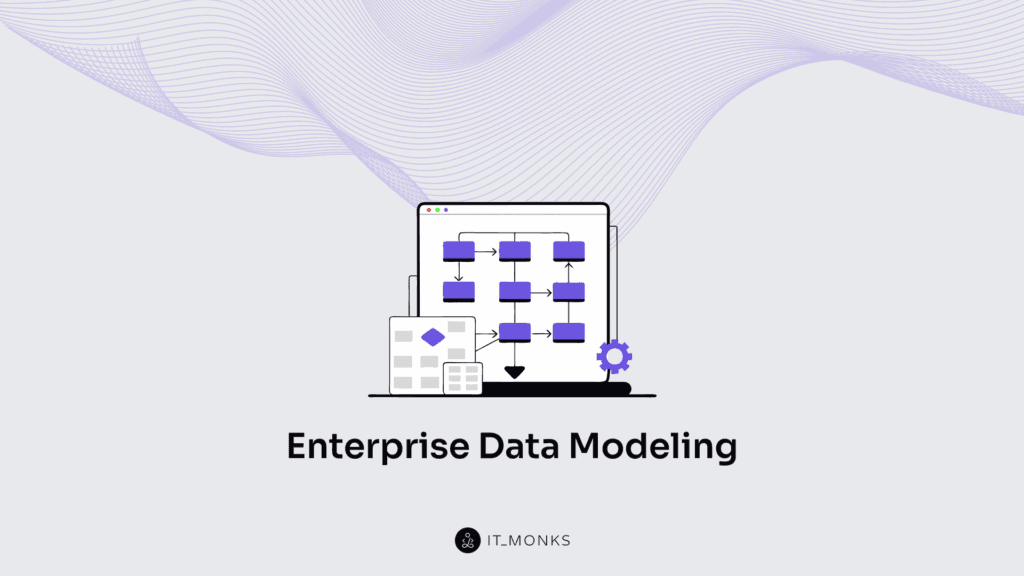
An enterprise data model is a comprehensive data structure that defines, organizes, and governs information assets across enterprise-level systems, serving as a foundational layer within scalable website architecture. It represents a unified schema that supports both backend logic and frontend delivery in high-traffic, modular environments.
Within enterprise website architecture, this model integrates multiple perspectives, including the subject area model, conceptual data model, logical data model, and physical data model, each describing different abstraction layers from business domains to system-level implementations.
For CMS platforms like WordPress, the enterprise data model must accommodate dynamic content structures through custom post types, advanced taxonomies, and metadata-rich field architectures. These implementations align content modeling with schema management principles.
To execute such models effectively, organizations apply formal techniques like entity-relationship (ER) modeling, UML-based schema definitions, and normalization-driven design, which optimize data integrity and extensibility across distributed systems.
The structural governance enforced by the enterprise data model becomes more complex with evolving digital infrastructure. It must respond to shifting requirements, versioned schema migrations, and adaptive content delivery mechanisms. This extends to API interoperability and synchronization with frontend systems — elements critical to maintaining consistency across channels and devices.
What Is an Enterprise Data Model?
An enterprise data model is a schema-based abstraction that defines how data entities and their relationships are structured, governed, and accessed within an enterprise website architecture. It is a strategic layer that organizes structured and unstructured data to reflect enterprise-wide business logic, security constraints, and integration points across platforms such as CMSs, ERPs, and APIs.
Within scalable website architecture, the enterprise data model standardizes how content types, user data, metadata, and system records interact, both logically and physically. It supports data governance through strict schema definitions and relationship mappings, while serving as the foundation for secure data access and modular application design.
The model defines how data is classified, stored, and connected across systems. It governs entity relationships across content types, governs schema evolution for scalability, and supports frontend/backend synchronization through API-bound data representations. It also facilitates consistent taxonomy structures and metadata schemas across CMS platforms like WordPress, especially when handling custom post types, taxonomies, and dynamic content.
By encapsulating core enterprise needs, such as relationship integrity, schema versioning, and abstraction layers, the enterprise data model acts as both a control system and a coordination layer for scalable, modular web architectures.
Role of Data Models in Enterprise Website Architecture
The enterprise data model governs the underlying structure of data used across the website architecture. It defines how entities, such as users, content types, taxonomies, and relationships, are logically grouped, referenced, and retrieved. This orchestration directly supports modularity, cross-platform integration, and interface standardization across high-scale systems.
Within the database layer, the model enforces schema normalization, which optimizes storage, reduces redundancy, and improves query efficiency. At the enterprise CMS layer, it defines the structure of content types, taxonomies, and fields, controlling what data can be created, how it’s validated, and how content relationships are maintained through reference integrity. In the API layer, the model determines payload structure, enforcing consistent query logic and predictable endpoint responses across services.
On the backend, entity relationships, defined within the model, translate directly into business rules and content governance logic. These definitions support automated validation workflows, role-based data visibility, and access control frameworks.
On the front-end, the model supports structured output: taxonomy-driven navigation, conditional content rendering, and localization structures depend on consistent data relationships defined at the model level.
The data model supports scalability by abstracting content schema from presentation logic, enabling modular expansion of content types and relationships without disrupting downstream systems. It supports governance by centralizing definitions and reducing schema drift across development, editorial, and API layers.
Compliance and security are enforced through role-based schemas, entity access rules, and tightly scoped data exposure definitions, which are embedded in both storage structures and API responses.
By defining how entities interrelate, validating input/output structures, and supporting layered separation across the architecture, the enterprise data model remains a control system that directs both the integrity and evolution of scalable content infrastructure.
Types of Enterprise Data Models
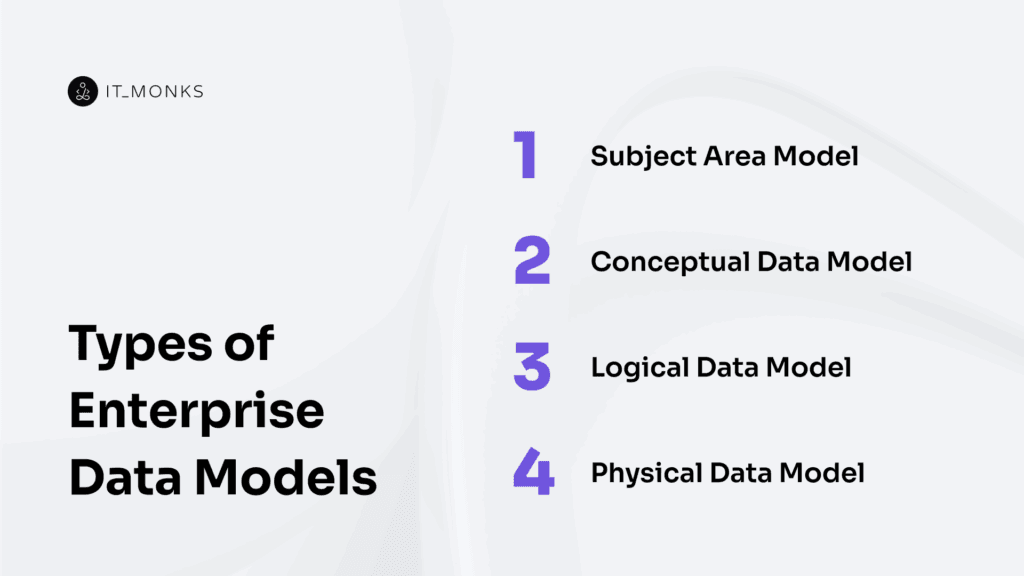
Data modeling within an enterprise architecture unfolds across several distinct but interconnected layers, each building upon the previous to support scale, governance, and long-term system integrity.
At the broadest level, the subject area model captures core domains and top-level groupings, ideal for executive and planning contexts where clarity and business alignment matter more than structural detail. This abstraction gives way to the conceptual data model, which begins to map specific entities and their relationships while remaining platform-neutral. It acts as the connective thread between strategic oversight and system design.
Further refinement happens at the logical data model stage, where entity attributes, data types, and interdependencies are defined with enough rigor to prepare for real-world implementation, yet without locking into physical infrastructure.
Finally, the physical data model operationalizes everything by encoding the logic into database tables, indexes, constraints, and storage formats tailored to the actual environment, whether it is SQL-based, document-oriented, or a distributed system.
Moving through these layers progressively aligns technical precision with business structure, making it feasible to deliver systems that are not only technically sound but also structurally stable across evolving platforms and traffic demands.
Subject Area Model
A subject area model is the highest-level abstraction layer of an enterprise data model, where data is grouped into business-relevant domains without mentioning entities, fields, or schema logic. These categories are defined by their role in the business structure.
Within enterprise website architecture, this model sets the foundation for how information is understood and prioritized across departments. It maps out the primary data domains without diving into the mechanics of how the data is stored or related. Instead, it defines the conceptual territories that enterprise systems, such as CRMs, CMS platforms, marketing automation tools, and regulatory compliance systems, operate within.
Subject area model provides a unified data vocabulary across content strategy, commerce operations, user segmentation, and internal workflows. For example, a website’s navigation strategy, CRM audience targeting, or marketing campaign segmentation often aligns with the same top-level subject areas like customer behavior, transactional history, or editorial content. The model ensures that these alignments are deliberate and rooted in shared business logic.
Because it abstracts away from technical implementation, this layer belongs in the realm of business architecture, not engineering. Subject area model exists to clarify scope, eliminate departmental silos, and anchor future data models around a stable, strategic structure. By identifying what types of data the business cares about before discussing how they’re structured or queried, it becomes the starting point for scalable, cross-functional data planning.
Conceptual Data Model
A conceptual data model is the second layer in the enterprise data modeling hierarchy, where entities and relationships are identified, but no attribute-level detail or schema logic is included yet.
Positioned as the second layer in enterprise data modeling, the conceptual model sits directly beneath the subject area model, which outlines broad functional domains, and precedes the logical model, which introduces structure, attributes, and rules. Here, the focus narrows from general business areas to identifiable entities such as “Customer,” “Order,” “Product,” or “Invoice,” and defines how these interact.
Relationships such as one-to-one (1:1), one-to-many (1:M), or many-to-many (M:N) are outlined to represent the conceptual flow of data, without specifying how those relationships will be implemented.
This layer often serves as the canonical model for a single subject area. For example, in a digital publishing architecture, the “Author” entity might relate to the “Article” entity through a 1:M relationship, while “Category” may relate to “Article” via M:N.
In the context of scalable enterprise website architecture, the conceptual model informs structural decisions by identifying core entities that are consistent across systems, including content management, personalization engines, external APIs, and data warehousing layers. This provides a durable conceptual anchor as systems evolve or expand.
The conceptual model creates the foundation that the logical model will soon refine, introducing field-level granularity and early schema constraints aligned with specific business rules.
Logical Data Model
A logical data model is the third modeling layer, where entities from the conceptual model are detailed with attributes, keys, and business rules, still in a platform-independent format.
This model introduces concrete definitions for each data element. An “Order” entity, for example, may include attributes like Order_ID, Customer_ID, Order_Date, and Total_Amount. Each attribute is associated with a descriptive data type, such as textual fields for names, numerical fields for prices and counts, or boolean flags for status indicators.
Unique identifiers (primary keys) are assigned, and connections to other entities are declared via foreign keys, like Customer_ID linking an order to a customer. These links are further shaped by cardinality rules: a single customer may be associated with many orders, but each order links to one and only one customer.
What distinguishes this model from the conceptual layer is its precision. Relationships now specify referential integrity, including one-to-many or many-to-many constraints. Naming conventions are applied consistently to match organizational standards. Where conceptual entities are abstract groupings, the logical model anchors those concepts to measurable, enforceable structure, defining, for instance, that “Email” must be unique or that “Published_Date” must follow a valid date format.
This precision is critical for enterprise website architecture. Logical modeling influences how content types in a CMS are structured, how consistent validation is handled across APIs and internal systems, and how frontend displays align with backend integrity. It creates a clear path for integrating external systems while maintaining a unified internal schema, especially for multi-departmental platforms where data flows through multiple interfaces.
As this model stabilizes, it forms the specification from which the physical data model is constructed, where storage formats, indexing, and performance optimization come into play.
Physical Data Model
The physical data model is the final and most concrete layer of enterprise data modeling, where all logic from the previous levels is translated into database-specific structures, including tables, columns, data types, indexes, and storage configuration.
Unlike earlier modeling layers, which focus on meaning and relationships, the physical model details the database schema in a format ready for deployment. Every table is explicitly defined, with columns assigned concrete data types—VARCHAR for text, INT for integers, BOOLEAN for binary flags, and so on. This layer also specifies primary keys and foreign key relationships, enforcing integrity at the database level.
Performance and scalability are major considerations. Indexes are defined to support query efficiency. Partitioning strategies may be introduced to handle large datasets. Materialized views or stored procedures can be used to optimize repeated access patterns. Even storage-specific features, such as row-based or column-based layout, may influence the schema at this stage.
Within enterprise website architecture, the physical model anchors the back-end data infrastructure. It’s what the CMS, APIs, and external systems ultimately query. A well-structured physical layer supports compliance by restricting data types, enforcing constraints, and defining secure access patterns. It also ensures that the data layer can scale with business growth, whether it’s a single WordPress deployment or a distributed microservice stack.
Data Modeling for CMS Platforms
In enterprise environments that rely on CMS platforms, data modeling must align with structured content, editorial processes, and integration points. These systems organize data objects like articles, locations, or team members as defined entities with fields, metadata, and relationships.
CMS platforms function as data layers within larger enterprise systems. They enforce content schemas, manage taxonomies, and support API-driven interactions. Every content type needs to be modeled with clear attributes and consistent logic to remain usable across systems and workflows.
In WordPress, a widely used CMS in enterprise settings, these models appear as custom post types, metadata fields, and hierarchical taxonomies. This structure helps map real-world entities into a content model that supports scale and integration.
WordPress Custom Post Types and Fields
Custom Post Types (CPTs) in WordPress are structured content objects defined at the database level. Each CPT introduces a new type of entity into the system, distinct from default posts or pages, with its own schema and behavioral rules. These entities serve as the backbone of complex data architectures in enterprise-scale WordPress environments.
Custom fields, which are key-value pairs stored in the database, provide attributes to these entities. When modeled strategically, a CPT, along with its associated fields, resembles a classic entity–attribute pair in a logical or physical data model.
For instance, a “Project” CPT might carry attributes like deadline, client, and budget, each mapped through custom fields. This aligns directly with relational data design, where each row (post) represents a discrete entity and columns (fields) carry attribute data.
Such a structure supports content scalability by decoupling data types from presentation logic. Developers can define and evolve content schemas without affecting frontend behavior, which is essential in high-scale environments. With field validation rules baked into form frameworks or custom admin interfaces, data consistency is enforced at the input level—an essential factor in enterprise-grade systems.
Moreover, this modeling approach supports robust API integration. Since CPTs and fields are stored in standardized database tables (wp_posts, wp_postmeta), they’re readily exposed through the WordPress REST API or GraphQL layers. This makes the system suitable for headless implementations or integration with external data systems where structure and schema uniformity are required.
Taxonomies and Metadata Structures
Taxonomies and metadata structures are a structural component of enterprise CMS architecture that organizes data through relationship and attribute logic. In scalable WordPress setups, they structure data into hierarchies like categories or segmentations, such as product types or industries. These structures control classification, filtering, and frontend visibility by encoding relationship logic between entities.
Custom fields handle metadata, adding attribute-level detail to each content item. They store values like SKU, region, or user access level, forming the retrieval layer that feeds templates, queries, and APIs. Where taxonomies shape how content is connected, metadata defines what each item holds.
Together, taxonomies and metadata introduce both hierarchy and specificity. This supports filtering, personalization, and structured delivery of content at scale. When paired with custom post types, they create the full CMS data model, ready for physical implementation.
Post types define what the content is. Taxonomies connect it. Metadata gives it detail. Together, they form the full data model behind enterprise CMS architecture.
Enterprise Data Modeling Techniques
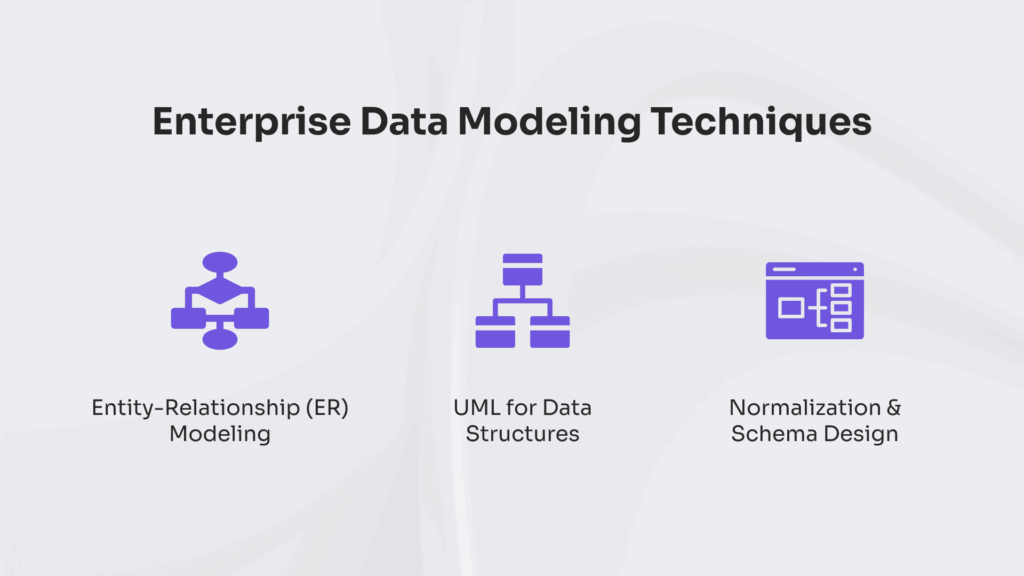
Enterprise data modeling techniques define the formal logic used to structure, visualize, and enforce data entities, relationships, and rules across a scalable enterprise website architecture. They’re execution tools applied within the modeling process to turn structure into implementation.
ER Modeling is used for mapping entities and relationships, giving form to how content elements like posts, taxonomies, and media are connected. UML helps formalize structure and show class and data behavior, which is useful in modeling how content and user interactions move between backend and frontend layers.
Normalization is applied to optimize the schema and remove redundancy, tightening data logic for performance and clarity in large content systems.
Enterprise data modeling techniques are used to implement and visualize data structures across enterprise CMS platforms and integrated website systems. They map relationships between content objects, structure backend data for frontend delivery, and optimize the schema to support scalable performance.
Whether tied into API endpoints or powering CMS architectures, enterprise data modeling techniques serve the structure that enterprise data models define.
Entity-Relationship (ER) Modeling
An entity-relationship (ER) modeling is a method used in enterprise data modeling to define content entities, their attributes, and the relationships between them. It supports the conceptual and logical layers of enterprise website architecture, forming the structure behind how data is organized across CMS platforms and API-connected systems.
Entities represent content types like User, Article, or Product. Each has attributes—fields such as Email, Title, or Price. Relationships describe how these entities connect, using patterns like one-to-many or many-to-many. Together, they form a structured map that supports content modeling across the CMS and ensures consistency in the underlying database schema.
An entity-relationship modeling method visualizes how content flows and interacts in large-scale systems. It supports enterprise-level CMS structure, informs backend schema, and aligns with API endpoints that rely on predictable data relationships.
ER modeling works alongside other modeling approaches but focuses on defining structure at a level abstracted from implementation, giving enterprise teams a clear framework to connect data meaningfully.
UML for Data Structures
The Unified Modeling Language (UML) is a standardized method for mapping out structured data in enterprise web systems. In data modeling, UML class diagrams define objects (data structures), their attributes (fields), and their relationships, supporting modular, scalable architecture.
Each class in UML represents a component of the system, showing what data it holds and how it connects to others. Relationships like composition and inheritance show how one structure contains or extends another. This is especially relevant in systems with reusable content blocks, plugin frameworks, or modular API layers.
UML fits well when components need to be reused across frontends, backends, and integration layers. It helps align structured content, like CMS entities or API payloads, with business logic without being limited to tables or storage layouts. Compared to ER models, UML focuses more on structure and reusability than on database schema.
For enterprise websites built with extensible, module-driven frameworks, UML supports a clear blueprint for how content structures behave and relate across systems.
Normalization and Schema Design
Normalization and schema design are techniques in enterprise data modeling used to reduce redundancy and structure data into relational formats through entities, attributes, and their relationships. It sets the foundation for how data is logically organized and physically stored across large-scale systems, translating abstract models into structured forms suitable for query performance and long-term scalability.
In the context of enterprise-grade website architecture, especially CMS-driven platforms like WordPress, normalization limits duplication across content types, taxonomies, and metadata layers. Without it, systems often end up bloated with repeated structures that degrade performance and complicate updates. Schema design defines the blueprint that guides how these normalized elements map into actual tables, columns, and keys.
This translation step between the logical model and the physical implementation defines not only the shape of the data, but also how it’s accessed, joined, and secured. A clean schema improves storage efficiency and update consistency while preserving referential integrity across interconnected systems.
In high-scale CMS environments, schema design becomes essential to govern content relationships across pages, media, user roles, and plugin-driven features. Whether modeling custom post types or handling external API integrations, normalized schemas prevent overlap and simplify logic propagation between frontend and backend systems.
Challenges in Enterprise Data Modeling
Enterprise data modeling introduces significant challenges related to data consistency, scalability, integration, and governance, especially as systems grow more complex and interconnected.
On the technical side, data often comes from fragmented systems: CMS platforms with custom fields, external CRMs, ERP tools, and APIs that rarely speak the same language. Mapping these into a unified model invites constant schema mismatches and drift.
A small change in one plugin or API can silently break frontend components or cause content to vanish from queries. This is especially common in CMS setups with layered taxonomies or post types that evolve independently across teams.
Operationally, disconnected ownership across departments slows everything down. Marketing, dev, and data teams often model the same objects differently — sometimes even within the same CMS. Without a clear structure, they step on each other’s changes, causing delays and redundant work.
When global teams operate across multiple environments, this confusion multiplies. Updates made in one region don’t match another, and no one’s sure which model is current.
Strategic issues show up in the absence of standards. Modeling decisions are often undocumented, and updates rarely follow a formal review process. Governance becomes reactive, not proactive. For organizations dealing with compliance, that’s a problem. Missing audit trails, inconsistent metadata, and unclear data retention rules create legal risks that aren’t always visible until it’s too late.
These gaps have real consequences, as poor models slow down performance, break internal search, and create friction for users. Over time, even small inconsistencies lead to bigger failures — from failed content migrations to broken API integrations and messy frontends that confuse users and editors alike.
Evolving Data Models in Modern Web Architecture
Enterprise data models are not static; they evolve alongside changes in web architecture, content systems, and integration strategies. As platforms shift toward scalable architecture and omnichannel delivery, data models face constant pressure to accommodate new structures and semantics.
The transition to modular CMS frameworks—especially headless systems—displaces traditional, tightly-coupled schema assumptions. Instead of one monolithic taxonomy, content must adapt to being delivered via APIs, requiring flexible entity definitions that work across disparate frontend environments. What was once a single “Post” entity now fragments into device-specific content variants, versioned field sets, and user-state-aware outputs.
Personalization introduces further shifts. Attributes such as “Author” or “Category” expand into behavior-based tags, recommendation scoring, or localization variants. Over time, this complexity changes relationships—one-to-many structures give way to many-to-many mappings across audiences and touchpoints. Deprecated fields persist as legacy debt, even as new attributes demand re-indexing and version control.
Agile development accelerates this flux. Schemas are committed, tested, and iterated like code. Architects and developers collaborate on evolving models, balancing governance with delivery agility. Enterprise data models aren’t built once—they’re rewritten at the pace of the system itself.
Data Model Integration with APIs and Frontend Systems
Execution starts with the structure. The enterprise data model forms the foundation, and once exposed through APIs, it defines how data is exchanged with frontend systems, CMS endpoints, and external platforms. Every integration, whether REST, GraphQL, or custom middleware, depends on this consistency to function at scale.
At the API layer, model entities must translate cleanly into payloads. Field names, types, and structures must match across systems. Validation logic ensures correct formats, and when models evolve, schema versioning prevents contract breaks. If APIs don’t reflect model changes, integrations fail and dependencies break.
Frontend systems are tightly bound to the data model. UI components depend on predictable field structures for rendering. Relationships in the model inform navigation: breadcrumbs rely on taxonomies, filters on relational data, and dynamic blocks on schema logic. Any mismatch disrupts interface behavior and weakens UX consistency.
Data also moves across systems in real time. Synchronization depends on stable contracts. Without versioned schemas and defined data flows, integrations with CRMs, analytics tools, or marketing platforms become unreliable. Interoperability only holds when the model stays aligned across all layers.
Contact
Don't like forms?
Shoot us an email at [email protected]

